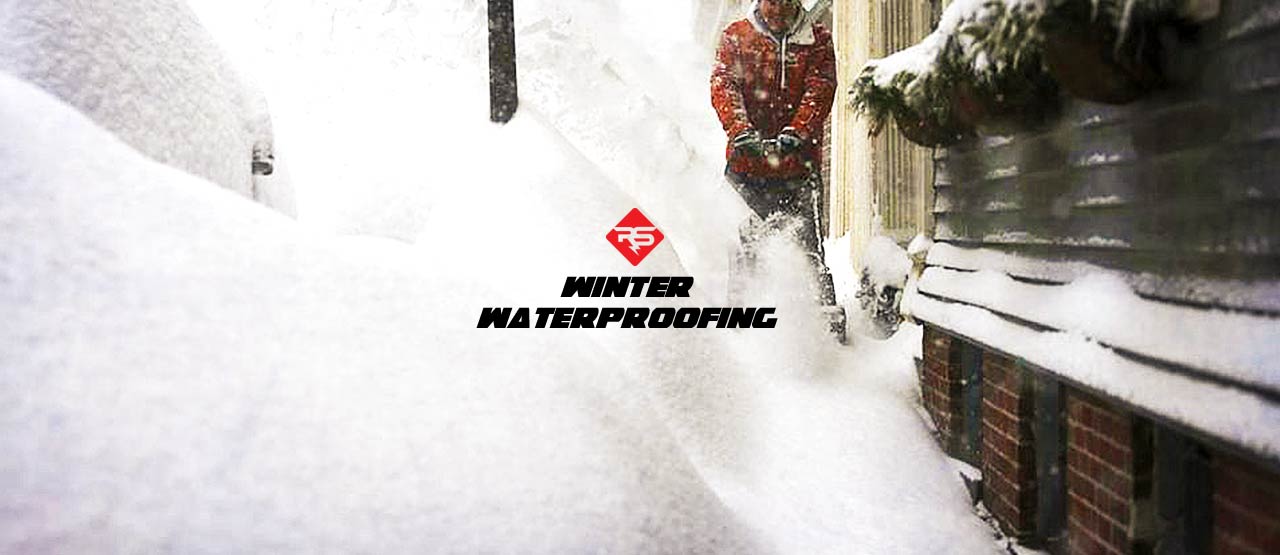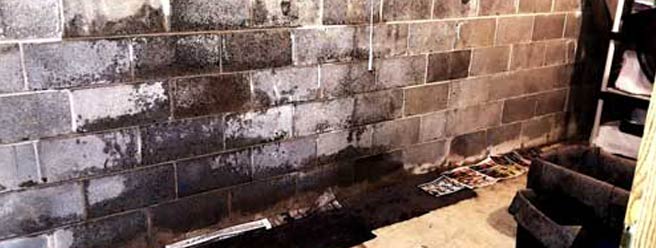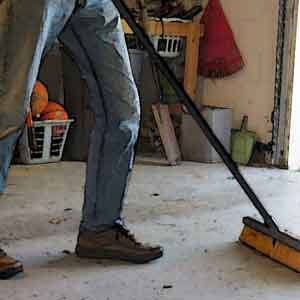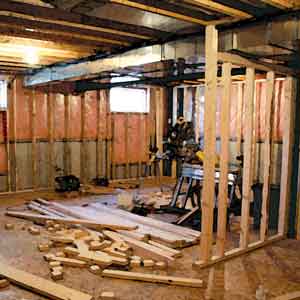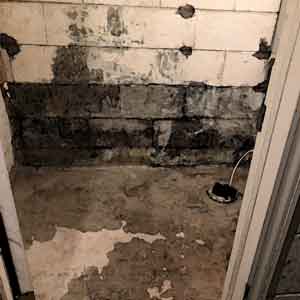Baby, It’s Cold Outside
It’s no secret that a dry basement can improve the health of your home and the well-being and safety of the people that inhabit it. Spending a winter’s day tending to an unfinished basement may not sound appealing, but the trade-off will be worth the effort come spring. Simple repairs can go a long way at achieving a healthier basement and there is no better place to start than in your subterranean basement or dank crawlspace.
“Is it too cold during the winter to seal my basement with your concrete care products?”
Winter is the ideal time to seal once damp foundation walls and basement floors before the arrival of spring’s snowmelt and rain.
Outdoor air temperatures may drop well below freezing but the soil temperature outside the basement walls will typically remain around 52° F, keeping the concrete temperature well above freezing. Low outdoor air humidity combined with heating from basement furnaces, boilers, and wood stoves, help reduce indoor humidity which allows the concrete to dry out thoroughly.
Drier concrete reduces the interference that excessive water may have when sealing and making concrete repairs. Freezing outdoor temperatures usually stops seepage of water through any cracks in the concrete. Settling cracks in foundation walls, or stress cracks in basement slabs, that are not actively leaking water in winter, makes for a much more successful repair.
Drier concrete makes it easier for RadonSeal Concrete Sealer to penetrate into the pores in concrete and react with alkalis in concrete.
It would be almost impossible to do this in spring, when the concrete pores and cracks are internally saturated with water. This is why the cold winter months make for the ideal time to repair cracks and seal your concrete!
Prevent Water Seepage in Spring
“Every spring my basement has that damp feeling to it. How can I prevent this from happening?”
The best practice for sealing your basement against the ingress of groundwater is to allow your concrete to thoroughly dry out. The reasoning behind this is, penetrating sealers work by absorbing through the surface cap and deep into the concrete. Filling the pores, capillaries, and micro-fractures that make concrete porous.
If there has been a considerable amount of rain or snow melt, resulting in excessive ground moisture and high-water tables, the concrete can be too damp which could inhibit the proper reaction or cure of the product.
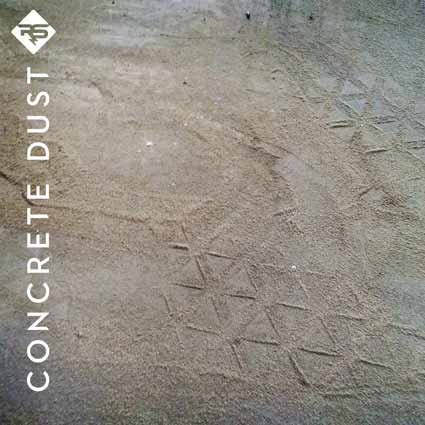
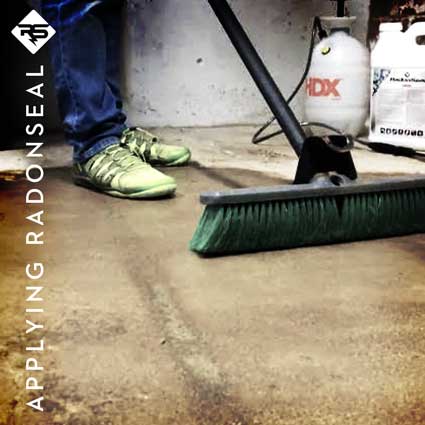
You Breathe in Concrete Dust
“We are turning our unfinished basement into a play space for the kids, but are concerned about the excessive amount of concrete dust on the basement floor. Should we be worried?”
In winter, people spend more time indoors and in their basements. If your basement is unfinished, the more susceptible you are too breathing in concrete dust. Every time something heavy is dragged across the surface, metal tools are dropped, toys are played with, or a cleaning broom is used, it grinds away small particles of the concrete surface.
Concrete dust is no ordinary dust! Dusting concrete contains sharp silicate particles (quartz) and alkaline compounds (mainly lime) which cut into the lungs and are corrosive to human tissue. Concrete dust can also aggravate bronchitis or asthma symptoms and crystalline silica is classified as a Group 1: Carcinogenic to Humans.
For more information on how to alleviate concrete dusting read Seal Your Basement Floor against Concrete Dust.
Radon Gas Levels Surge in Homes During Winter
“Why do the radon levels in my basement fluctuate higher in the winter, but drop in the summer?”
Radon levels in homes normally elevate in winter and can easily double or triple compared to testing during warmer months. An obvious reason for this is due to doors and windows being closed which decreases ventilation compared to warmer months when air flow increases because windows and doors are open more often.
Radon gas, released by radium in the earth, gets trapped under waterlogged ground and ice or snow cover. The gas then naturally flows to the disturbed ground around basements. With a greater vacuum effect in the house during cold months, warm air that rises and escapes, is then replaced by air from the soil (through concrete, cracks, and openings). This replaced air contains certain levels of radon gas.
Radon gas causes lung cancer and is a Class 1, human carcinogen. The risks are higher for women and particularly, children.
Waterproofing Checklist for Basements and Crawlspaces
√ Seal and waterproof unpainted concrete; foundation walls, basement floors, crawlspaces with RadonSeal Deep-Penetrating Concrete Sealer. RadonSeal will help minimize future dampness and harden the surface of the concrete to help alleviate concrete dusting.
√ Repair settling cracks in poured concrete foundation walls, cracks in concrete blocks, and fissures in mortar joints.
√ Repair hairline stress cracks in basement floors.
√ Fill expansion joints, saw cuts, floor-to-wall joints, or larger cracks (>1/4”).
√ To prepare for high sump water flows and potential power outages, consider installing a Hi & Dry Emergency Backup Sump Pump (water-powered backup pump).
√ Alleviate musty basement odors using BioZap All-Natural Air Purifier & Deodorizer
User Reviews Waterproofing Concrete, Wet Basements, Roofs, and Koi Ponds
The Best Basement Care Products
RadonSeal Concrete Sealer – Penetrates deep into concrete, chemically reacts, expands inside and seals the pores of concrete as an insoluble mineral. Use to seal against water seepage, dampness, radon gas, efflorescence, and concrete dusting.
IonBond Armor Elastomeric Sealer – Use for sealing thin concrete slabs commonly found in crawlspaces or historic homes, use in combination with RadonSeal on overly porous cinder block walls for the tightest concrete seal possible against moisture and water vapor.
RadonSeal DIY Foundation Crack Repair Kits – Two-component, low-pressure, professional-grade urethane or epoxy injection for filling and waterproofing settling cracks in poured concrete walls.
CrackWeld Concrete Floor Crack Repair Kit – Quickly and easily repair hairline cracks in basement floors. No routing or chasing of the crack required! Simply inject the two-component, self-leveling resin into the crack without the need to enlarge it.
ElastiPoxy Joint & Crack Filler Kit – Repair spalls, flaking, or pitting concrete. Fill control joints, cracks in concrete blocks, saw cuts, or floor-to-wall joint gaps using this strong, but flexible, two-component epoxy based sealant. Use also to fill holes, mortar joint repairs, or skim coat excessively leaking concrete blocks.
Hi & Dry Emergency Water-Powered Backup Sump Pump – These unique pumps require no batteries and are installed outside the sump basin. High above the sump water for unsurpassed pumping capacity, reliability, and performance.
